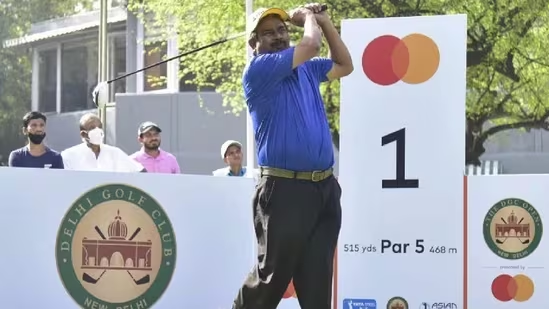Protracted battle for greens puts spotlight on caddie pros
Asked to reflect on his golfing journey, Ali Sher pauses. Not easy to summarise a lifetime in a few sentences, he says. But goad him on his defining moment on the iconic greens of the Delhi Golf Club (DGC) and the 63-year-old’s enthusiasm bubbles over.

“Oh, that was ages ago,” he says with a laugh. We are, of course, referring to his epochal Indian Open win in 1991, a feat still spoken of with reverence in Indian golf circles.
The history of Indian golf is intertwined with the coming of age of caddie pros. A generational switch arrived with Sher becoming the first Indian pro winner of the Indian Open. Jamshed Ali in the 1970s, Basad Ali in the ’80s and Feroze Ali in the ’90s asserted themselves before DGC’s Ashok Kumar — son of a carpenter, he caddied for top amateur Amit Luthra and went on to win 13 times on the Professional Golf Tour of India (PGTI) — took the baton.
Current PGTI Order of Merit leader Om Prakash Chouhan is a caddie-turned-pro, as is S Chikkarangappa, who has 14 PGTI wins. Caddie pros account for around half of the 300-odd pros on the Indian tour, a PGTI spokesperson said.
Sher turned professional in 1982 but it took him another six years to be able to afford his own golf gear. He was still better off than the likes of C Muniyappa, a product of the famed KGA Golf Club in Bengaluru, who had to make do with tree branches for clubs.
Things are different now, with tales of rags-to-riches caddie pros becoming increasingly distant. None among the current lot of top Indian golfers, the likes of Anirban Lahiri, Shubhankar Sharma, Manu Gandas, and Veer Ahlawat, ever needed to caddie, making the likes of M Dharma, Chikkarangappa, and SSP Chawrasia exceptions rather than the rule. It doesn’t help that over the past few years, at least 15 caddie pros have been shunted out of the DGC and despite both parties presumably open to talks, the matter currently rests in Delhi High Court.
Set in the heart of the capital, Lodhi Golf Club came into being in the early 1930s and was rechristened as DGC in 1951. As of now, this sought-after club has over 5,000 members.
While no office bearer, past or present, could tell the number of caddie pros who currently play at DGC, people in the know of things claimed the number is not more than five.
“How’s that for equality?” quipped Rashid Khan, a two-time Asian Tour winner currently leading aggrieved caddie pros’ charge against DGC, his home course.
The friction between the club and caddie pros first emerged in 2016 but the situation was settled through negotiations. Things started going south rapidly two years later, when a number of homegrown pros, including Rashid, were denied green time.
The caddie pros were given a slot of 4.15pm during winter months, allowing them just enough time to play a few holes.
The current bunch of caddie pros that play at DGC, however, deny facing any such restrictions. “We can pretty much walk in any time and play. There are no problems in the summer months when we tee off at around 8am. In winters, there is always some rush due to fading light but that’s same for everyone,” said Sachin Baisoya, a caddie pro who plays at DGC.
The aggrieved golfers, however, cite a 2017 letter (copy with HT) from the urban development ministry that ordered DGC to ensure “10% of the total intake to ‘Indian Business’ categories may be reserved for memberships to professional golf players of all levels to Delhi Golf Club”.
In 2019, the feud between DGC and caddie pros hit its nadir when club security didn’t let the golfers enter the facility. The golfers rang up the police who instead detained them.
“That was a result of sheer indiscipline on golfers’ part,” said RS Bedi, then DGC president. “They misbehaved with the staff, verbally abused the starter, and had a scuffle with the security guard. And as far as the ministry’s letter is concerned, I think the call to allot quotas rests with the club.”
The golfers approached the high court in February 2020, and 22 hearings later, there is no end in sight. They don’t have a lawyer currently — they claim at least four lawyers have left their case midway. Their next hearing is listed on August 14.
The golfers call the fight a class divide. “We were not allowed to use the washrooms or drink water in the clubhouse or annexe. There’s a washroom and a drinking water facility close to the parking, which is where we were supposed to go,” said Gulfam Pappan, another homegrown professional who now does coaching gigs in Noida to make ends meet.
DGC refuted the allegations. “The issue involved some indiscipline from those golfers. They wanted certain privileges that even the members do not have...they wanted to tee off anytime, walk into the club any time. As far as classism is concerned, that’s not a fair argument. We have strict rules even for the members who indulge in such unacceptable behaviour,” club captain Raj Khanna said.
Thriving in wilderness
Shamim Khan takes his time assessing the non-existent slope, slips into his stance, and sends the ball a hundred yards. In a parallel universe, the tee shot would have drawn an ovation from a packed clubhouse, but on these rugged greens, Shamim has no takers.
The dug-up dirt road that runs next to the graveyard and leads to this untouched patch of green is a nightmare to navigate, more so in monsoons.
Barely 10km from DGC, this is where Shamim, a caddie-turned-15-time PGTI winner, and his ilk have been practising for five years. While the likes of Rashid and Honey Baisoya have found refuge in courses in Noida and Gurugram, things are different for the likes of Shamim.
Golfers including domestic stalwart Mukesh Kumar allege that class problem is typical of some of the larger civilian clubs. Bred on the army golf course in Madhya Pradesh’s Mhow, Mukesh said, “Indian Army doesn’t believe in discrimination of any sort. Things at civilian courses may be different though.”
Ashok Kumar agrees. “I never went to school, never had any money. Golf gave me everything. But I can’t deny that golf does have a class problem. When you travel on a bicycle and your fellow player rides a Mercedes, it is obvious he/she will look at you differently. I learned to live with it,” he said.
Disclaimer: The copyright of this article belongs to the original author. Reposting this article is solely for the purpose of information dissemination and does not constitute any investment advice. If there is any infringement, please contact us immediately. We will make corrections or deletions as necessary. Thank you.







